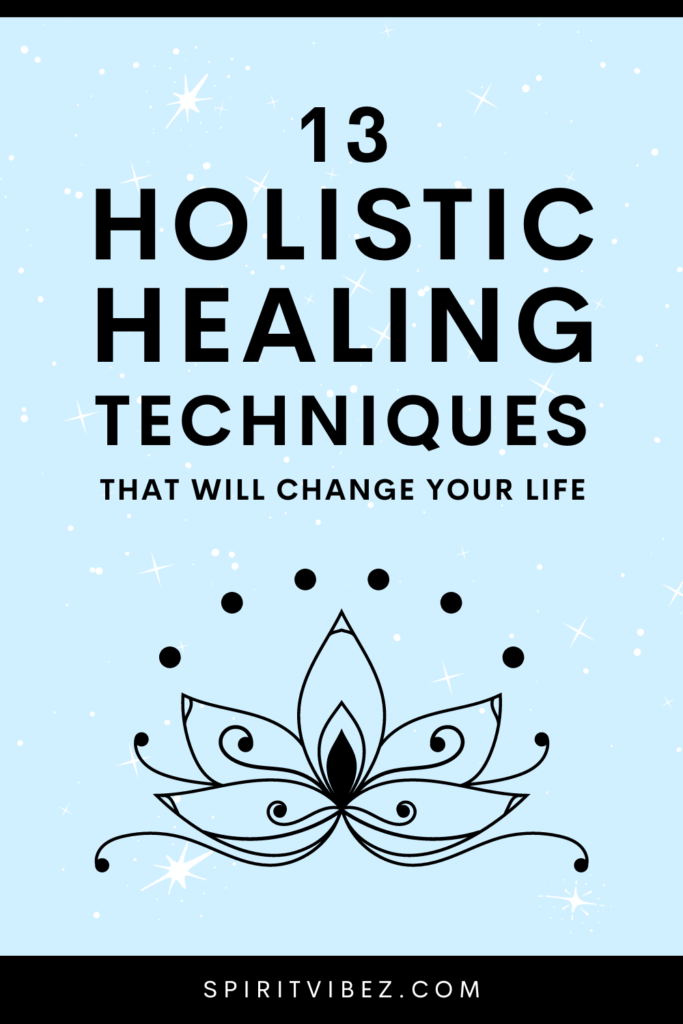Last Updated on December 14, 2023

Embarking on a journey toward well-being often calls for exploring holistic healing techniques that extend beyond conventional practices. And in today’s busy world, discovering transformative approaches to enhance your life can be a game-changer.
In this article, you’ll discover 13 holistic healing techniques that will change your life. Whether you’re seeking stress relief, improved mental clarity, or a deeper connection with yourself, these techniques will truly help you on your path to holistic health.
What is holistic healing?
Holistic healing is an approach that considers the interconnectedness of the mind, body, and spirit, recognizing that these aspects collectively contribute to overall well-being.
Unlike traditional medicine, which often focuses on treating specific symptoms or isolated areas, holistic healing seeks to address the root causes of imbalances, promoting harmony and health on multiple levels.
At its core, holistic healing involves viewing yourself as a whole entity, taking into account physical health, mental health, emotional well-being, and spiritual fulfillment.
This approach encourages a proactive stance toward your health, emphasizing the importance of preventive measures and lifestyle choices that support the body’s natural healing mechanisms.
Holistic healing often incorporates diverse ranges of holistic practices, including nutrition, exercise, mindfulness, alternative therapies, and spiritual exploration. It recognizes the profound impact of lifestyle, stress, relationships, and the environment on health.
Ultimately, the goal of holistic healing is to achieve balance and vitality, fostering a sense of wholeness that extends beyond the absence of illness to encompass a fulfilling and harmonious life.
Keep reading to discover how to start healing holistically with 13 life-changing techniques.
13 holistic healing techniques
Below are some powerful techniques and habits that will change your life, but it’s important to note that holistic healing is a personal journey, and what works for one person may not work for another.
1. Meditation and mindfulness
Meditation and mindfulness practices involve cultivating a focused and present state of mind.
Regular sessions, even brief ones, can lead to transformative benefits such as improved self-awareness, reduced stress, and a heightened sense of inner peace.
By embracing these techniques, individuals often find themselves better equipped to navigate life’s challenges with a calm and centered approach, fostering emotional resilience and well-being.
2. Yoga
Yoga is a holistic healing technique that extends beyond conventional exercise, offering a transformative journey for physical, mental, and emotional well-being. Emphasizing the integration of body and mind, enhances flexibility, strength, and balance, fostering overall physical resilience.
Yoga transcends the mat, promoting relaxation, stress relief, and a profound sense of calm in daily life. The meditative aspects and intentional breathwork of yoga serve as potent tools for combating stress and contributing to emotional well-being.
Regular practice cultivates emotional resilience, providing valuable tools to navigate life’s challenges with a centered and balanced mindset.
3. Plant-based diet
Embracing a nutrient-dense plant-based diet is a transformative step toward optimal health.
A diet rich in whole foods, including fruits, vegetables, plant proteins, and whole grains, provides the body with essential nutrients for energy and vitality.
Beyond physical benefits, you can expect improved mood, mental clarity, and a sense of overall well-being.
This shift in nutritional focus serves as a foundational pillar for holistic healing, supporting the body’s natural functions and promoting a healthier, more balanced life.
4. Energy healing
Energy healing practices, like Reiki, tap into the body’s subtle energy systems to promote balance and harmony.
By facilitating the flow of positive energy, you can experience profound relaxation, emotional release, and a sense of spiritual connection.
These practices work on multiple levels, addressing both physical and energetic imbalances, and are often described as transformative due to their ability to enhance overall well-being and catalyze personal growth.
5. Emotional release practices
Expressive art therapies, breathwork, and other emotional release practices offer transformative outlets for processing and releasing pent-up emotions. These cathartic techniques allow you to explore and express your feelings creatively, leading to emotional clarity and a sense of relief.
By addressing emotional blockages, individuals often experience increased emotional resilience, improved interpersonal relationships, and a renewed sense of emotional well-being.
These practices serve as powerful tools for personal growth and healing.
See also: How to release negative emotions
6. Forest bathing and nature connection
Immersing yourself in nature through forest bathing offers a profound experience that transcends typical outdoor activities.
Forest bathing involves mindfully engaging with the natural environment, leading to reduced cortisol levels, improved mood, and heightened well-being.
Spending time in nature provides a unique opportunity for stress reduction, enhanced mindfulness, and a deeper connection with the world around you.
To integrate forest bathing into your life, set aside dedicated time for nature walks or hikes, fully engage your senses, and disconnect from electronic devices to fully absorb the therapeutic benefits.
See also: How to connect with nature
7. Breathwork techniques
Conscious breathing practices, such as diaphragmatic breathing and pranayama, can be transformative for emotional well-being.
Diaphragmatic breathing involves inhaling deeply through the diaphragm, activating the body’s relaxation response.
Pranayama, a yogic breathing exercise, balances energy and promotes a calm state of mind.
The benefits of breathwork include stress reduction, enhanced mindfulness, and emotional regulation.
Incorporate these practices into your daily life by integrating deep breathing exercises during moments of stress, or as part of your meditation or yoga routine.
See also: 5 life-changing breathing exercises to release trauma
8. Ayurveda lifestyle practices
Ayurveda, an ancient system of medicine, offers a personalized approach to well-being based on individual constitutions or doshas (Vata, Pitta, Kapha).
The holistic practice of Ayurveda includes dosha assessments and provides recommendations for daily routines, dietary choices, and herbal remedies.
The benefits of Ayurveda encompass balanced health, prevention of imbalances, and support for overall well-being.
To incorporate Ayurveda into your life, consult with an Ayurvedic practitioner for a personalized assessment and experiment with Ayurvedic recipes and practices aligned with your dosha.
9. Crystal healing
Crystal healing involves using crystals to balance and align energy, promoting overall vitality and well-being. The transformative effects are often reported as increased clarity, emotional balance, and a sense of alignment with one’s spiritual self.
Select crystals based on their unique properties, and place them on or around the body during meditation or carry them as wearable accessories.
To incorporate crystal healing into your life, research crystals that resonate with your intentions, and remember to cleanse and charge them regularly to maintain their energetic properties.
See also: Crystals for positive energy in your home
10. Sound healing
Sound healing, a form of vibrational therapy, utilizes instruments like singing bowls, gongs, or tuning forks to produce vibrations believed to promote healing.
It induces a state of deep relaxation, reducing stress and tension, and can facilitate emotional release.
To explore sound healing, attend sessions or workshops led by experienced practitioners, or incorporate calming music or soundscapes into your daily routines to enhance relaxation and mindfulness.
11. Exercise
Regular physical activity is a transformative practice that positively impacts both the body and the mind. Exercise not only contributes to physical fitness, strength, and flexibility but also plays a crucial role in supporting mental health.
Engaging in activities such as cardiovascular exercise, strength training, or even mindful movement like tai chi or Qigong can release endorphins, reduce stress, and improve overall mood.
The transformative benefits of exercise extend beyond the physical realm, promoting cognitive function, enhancing sleep quality, and fostering a sense of accomplishment.
To incorporate exercise into your routine, choose activities you enjoy, set realistic goals, and make movement an integral part of your holistic well-being journey.
12. Holistic beauty and self-care rituals
Holistic beauty practices prioritize self-love and well-being over external appearance alone. This involves using natural and non-toxic skincare products and incorporating mindful self-care rituals such as facial massages and aromatherapy.
The benefits encompass inner well-being, a boost in confidence, and a radiant, holistic approach to beauty.
To create holistic beauty routines, choose skincare products with natural ingredients and develop personalized self-care rituals that incorporate mindfulness and intention.
See also:
13. Mind-body practices for sleep
Establishing mind-body practices for sleep involves adopting calming bedtime rituals and creating a sleep-conducive environment. This includes activities like reading, gentle stretching, or meditation.
The benefits of such practices include improved sleep quality, stress reduction, and a peaceful mindset before bedtime.
To incorporate mind-body practices into your sleep routine, establish calming rituals and create a sleep-conducive environment with dim lighting, comfortable bedding, and a cool room temperature.
Conclusion
It’s essential to recognize that embracing positive change often begins with small, intentional steps.
Whether you find solace in mindfulness practices, sound healing, or the rejuvenating power of nature, the key is to prioritize your well-being.
Integrating these holistic approaches into your daily life can lead to profound transformations, fostering a healthier mind, body, and spirit.
In the tapestry of holistic healing, there’s no one-size-fits-all solution. Experiment with these techniques, adapt them to your lifestyle and allow the positive shifts to unfold naturally.
Change is a constant, and by incorporating these practices, you’re opening doors to a life that resonates with balance, resilience, and a renewed sense of vitality.
So, as you step forward into this journey of self-discovery and holistic well-being, may each day become an opportunity to cultivate a harmonious and fulfilling existence. Here’s to a life enriched by the transformative power of holistic healing.
If you enjoyed this article with 13 holistic healing techniques, I would be grateful if you shared it on Twitter, Facebook, or Pinterest! Thank you❤️
📌 PIN THIS POST FOR LATER


Hello, my name is Sara and I am the founder of Spiritvibez, I’m here to guide you on your spiritual journey toward healing, growth, and self-discovery. I believe that true transformation occurs when the mind, body, and spirit are aligned and working in harmony. Through Spiritvibez, I hope to inspire and empower you to deepen your spiritual practice, embrace your authentic self, and begin living your best life.
